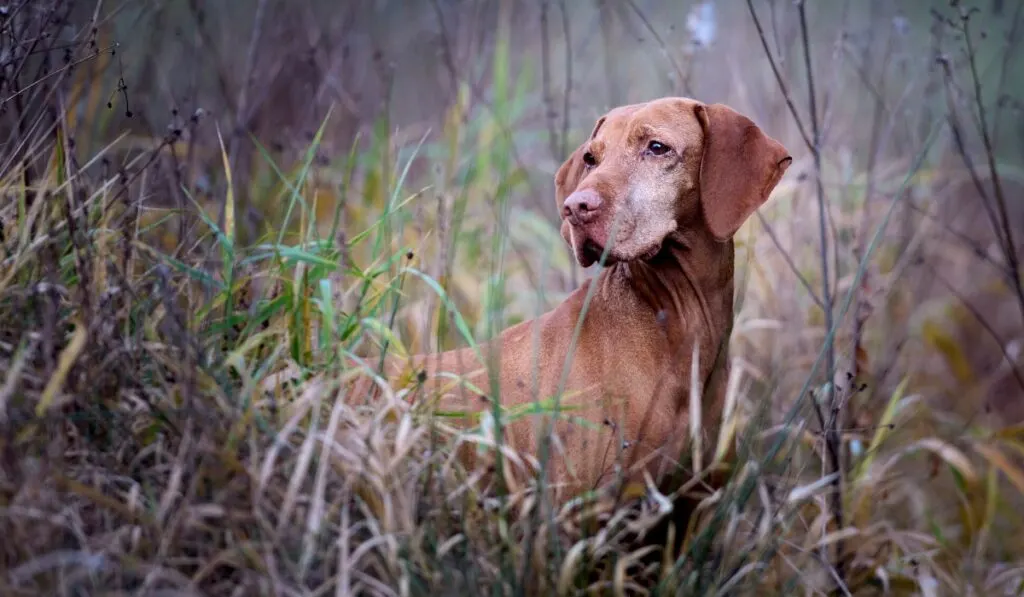Something that both puzzles and concerns many vizsla owners is the appearance of grey hairs.
Vizslas have such a gorgeous golden color, that it makes greying all that more difficult to accept.
So why does the greying happen? Will all vizslas go grey? And at watch age? There are many great questions surrounding this topic, and everything you need to know is below.

Table of Contents
Why Do Vizslas Go Grey?
Genetics, stress, and the natural aging process are the three main reasons that cause Vizslas to go grey. Greying can also be the result of certain health issues like hypothyroidism, but that’s much less common.
As with humans, genetics and stress are the two main causes for all dogs, not just vizslas, for going gray.
Stress is of course quite a broad term and covers many different areas of your Vizslas overall life. More on this below.
Do Vizslas Have The Greying Gene?
The “greying gene” is very much a real thing, otherwise known as the “progressive greying gene”.
However, this exact gene has not yet been found in Vizslas, and only affects a small selection of breeds. This could change as research continues.
This, however, doesn’t mean that genetic greying isn’t possible in Vizslas. And to some extent, you can look to the parents of your Vizsla to get an insight into what your V might look like when he’s older.
If one parent has gone grey, then there’s a chance your V will eventually go grey too. If both parents are considerably grey, this, of course, suggests your Vizsla will almost certainly end up going grey akin to the parents.
Although somewhat of an unprofessional take on it, looking to the parents is a pretty safe bet.

Can The Greying Be Caused By Stress?
The second most common reason for greying in Vizslas comes down to stress.
➡️ Interesting Fact: According to science, stress and going grey is as likely to happen in canines as it is in humans.
Researchers from the University of Northern Illinois conducted a study consisting of 400 dogs, ages 1-4. The willing participants were unknowing of the purpose of the study to help it remain unbiased. The owners answered questionnaires and provided photos of their dogs.
From the type of questions answered along with the photos given, the researchers were able to make a positive correlation between premature greying and the likely phycological stress levels based on the lifestyle questions asked and the respective answers that were given.
It’s important to keep in mind, “canine-stress” can be as broad as it with humans, and many different areas of a dog’s life can contribute to stress.
Lifestyles, daily routines, stimulation, environmental factors, exercise levels, quality of diet, interaction levels, the quality of the relationship between the dog and their owner, and even health issues, all factor into overall stress levels.
Your Vizsla might well be living the good life, but if just one area of his life is lacking or causing him extra anxiety, then stress could be the result.
Age-Related Greying
If your Vizsla hasn’t already gone grey from either genetics or stress, there’s always the good old aging process to fall back on!
But in all seriousness, the natural aging process does cause canines to grey just as it does in humans.
If it’s old age that causes your Vizsla to go grey, the first place it usually starts is around the muzzle. For some, it will stop at this point, but for others, the grey hairs will start appearing in more places all over the body.
When Will Your Vizsla Go Grey?
Without a doubt, the biggest concern most owners have is about knowing when their vizsla will go grey? Will your vizsla go grey prematurely?
First of all, not all vizslas end up going grey! And many keep their golden brown and reddish tones their entire life. So that’s definitely worth keeping in mind.
Some Vizslas will start showing grey hairs around their muzzle from about 4 years onwards, but for others, it might not happen until around 7-8 years of age. The truth is that it varies and there is not a golden age that all vizslas turn grey.
Additionally, the rate at which the gray hair comes through also changes.
For some, the grey hairs will come through thick and fast, but for others, the hairs will come through slowly over the course of years gradually reducing his natural coat color.
Whether or not your Vizsla will go grey prematurely will come down to genetic, stress, and health issues as explained above. This also depends on what age you consider “premature”…
Where Do Vizslas Go Grey?
The majority of vizslas start going grey around their muzzle and face.
For some, it may even stop there, at the face. But for others, the grey hair will continue to come through in different places over the body including the underbelly, neck, and back area as well as the paws and legs.
Some Vizslas will end up with their entire coat going grey to some extent.
Health Issues That Might Cause Greying In Vizslas
Although highly unlikely, there is still a slight possibility that greying could happen as a result of a health issue rather than from genetics or stress.
The most common canine health issue that could potentially cause the greying of hair would be hypothyroidism.
Hypothyroidism is a fairly common issue and has many symptoms, some of which are related to the skin and coat. Hair-loss, excessive shedding, poor hair growth, changing of pigments, and greying in the face and around the muzzle are some of them.
If you suspect your Vizsla has an underlying health issue then you should always seek veterinary help as soon as possible.
Is your vizsla going grey? Let us know and provide your photos! Additionally, if you have any further information that you think will help future Vizsla owners, I’d love to hear it!
Be sure to check out more Vizsla Articles on The Puppy Mag.
